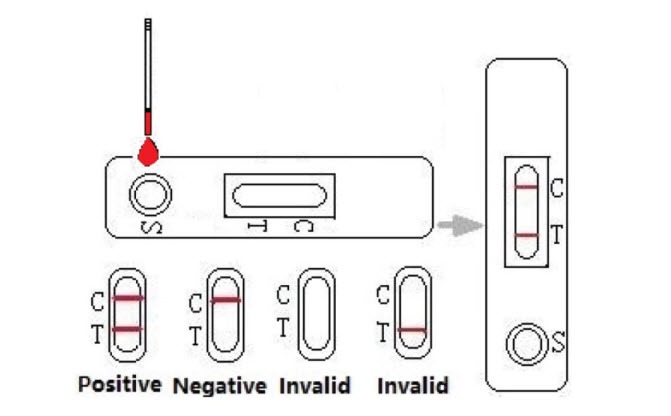Table of Contents
Herpes Simplex Virus Type 2 (HSV-2) is a significant concern due to its asymptomatic nature and potential health implications. Early detection through the HSV-2 IgG Home Use Rapid Test Kit provides a convenient, private, and quick method for individuals to assess their status. This guide offers a detailed, step-by-step illustration on how to use this kit effectively at home.
Introduction to HSV-2 and the Importance of Early Detection
Understanding the nature of HSV-2 and the critical role of early detection is essential for managing and preventing the spread of this virus. The HSV-2 IgG Home Use Rapid Test Kit offers a reliable solution for individuals to conduct self-testing in the privacy of their homes.
Step-by-Step Guide to Using the HSV-2 IgG Home Use Rapid Test Kit
Step 1: Preparation
- Gather Your Materials: Ensure you have the test card, sample buffer, alcohol swab, safety lancet, and plastic dropper, all of which are included in the kit.
- Room Temperature: Before starting, bring all components to room temperature for optimal performance.
Step 2: Specimen Collection
Whole Blood Collection
- Clean the Finger: Use the alcohol swab to clean the finger you will be using for the blood sample. Allow it to dry.
- Prick Your Finger: Use the safety lancet to prick the side of your fingertip. Avoid using the very tip or the pad.
- Collect the Blood: Allow a drop of blood to form and use the plastic dropper to collect it. Ensure the dropper is filled to the indicated line without creating air bubbles.
Serum and Plasma Collection
- Blood Draw: If you’re using serum or plasma, draw blood into a container without anticoagulants.
- Storage: If not testing immediately, store the serum or plasma in a refrigerator or freezer and bring to room temperature before testing.

Step 3: Applying the Specimen
- Open the Test Kit: Carefully open the pouch and lay the test card flat on a clean surface.
- Apply the Specimen: Transfer 5 μL of the blood sample or serum/plasma to the sample well of the test card.
- Add Buffer: Immediately add 2 drops of the sample buffer into the same well.
Step 4: Reading the Results
- Wait: Allow the test to process for 15-20 minutes. Do not interpret the results after 20 minutes as this could lead to inaccuracies.
- Interpret the Results:
- Negative: A single pink band appears in the control region, indicating no detectable anti-HSV-2 IgG.
- Positive: Two pink bands appear, one in the test region and one in the control region, indicating the presence of anti-HSV-2 IgG.
- Invalid: If no bands appear, or if the control band fails to appear, the test is invalid and should be repeated with a new kit.

Precautions and Recommendations
- Use fresh specimens and avoid repeated freezing to ensure valid results.
- The test kit is for single use. Do not reuse.
- Do not use beyond the expiry date or if the pouch is damaged.
- Dispose of the kit responsibly following local regulations for infectious materials.
Conclusion
The HSV-2 IgG Home Use Rapid Test Kit is a valuable tool for individuals seeking to understand their HSV-2 status. By following these steps, users can ensure accurate results and take appropriate measures based on their testing outcomes.
FAQs About HSV-2 IgG Rapid Test Kit
How soon after possible exposure can I accurately test for HSV-2 using the IgG Rapid Test Kit?
The HSV-2 IgG antibodies typically take 4–6 weeks after initial exposure to develop at detectable levels. For the most accurate results, it's advisable to wait at least 4–6 weeks after potential exposure before taking the HSV-2 IgG Rapid Test. Testing earlier might lead to false-negative results due to insufficient antibody development.
What actions should I take if my HSV-2 IgG Rapid Test result is positive?
If your HSV-2 test result is positive, consider the following steps:
- Remain Calm: A positive result means you’ve been exposed to HSV-2. Many people manage this condition effectively.
- Confirmatory Testing: Visit a healthcare professional for confirmatory testing and a medical assessment.
- Discuss Treatment Options: Discuss antiviral medications and symptom management strategies with your doctor.
- Notify Partners: Inform sexual partners so they can also get tested.
- Lifestyle Adjustments: Consider lifestyle changes to manage symptoms and reduce transmission risks, such as using protection and recognizing outbreak triggers.
Is it possible to get a false-positive or false-negative result with the HSV-2 IgG Rapid Test Kit?
While rare, false-positive or false-negative results can occasionally occur:
- False-Positive: May occur due to cross-reactivity with antibodies from other infections or autoimmune conditions. A confirmatory test from a healthcare provider is advisable if results seem unexpected.
- False-Negative: Typically occurs if testing is performed too early after exposure (before antibodies develop). Retesting after 6–8 weeks is recommended if initial tests are negative but suspicion remains.
Always consult with a healthcare professional if you're unsure or receive unexpected results.
How should I properly dispose of the used HSV-2 IgG Rapid Test Kit?
Proper disposal ensures safety for you and others. Follow these disposal guidelines:
- Place the used lancet and any blood collection items into a puncture-proof sharps container or sturdy, sealed plastic container.
- Dispose of the used test card and packaging materials in regular household waste, unless otherwise specified by local regulations.
- Always comply with local guidelines for disposal of biomedical or hazardous waste.
How frequently should I retest for HSV-2, especially after receiving a negative result?
Retesting is important, especially if:
- You tested negative but continue to have symptoms or concerns.
- You have ongoing exposure risks, such as multiple sexual partners or unprotected sexual activities.
Typically, healthcare providers recommend annual screening or testing every 6 months if you’re sexually active with multiple partners or engage in high-risk behaviors.
Are there any limitations or special considerations when using the HSV-2 IgG Rapid Test Kit at home?
Yes, there are certain limitations to consider:
- The test only detects IgG antibodies to HSV-2, indicating past exposure but not necessarily current active infections or outbreak status.
- It does not distinguish between recent or older infections.
- It's not designed to diagnose other types of herpes viruses like HSV-1.
- Confirmatory testing and medical consultation are recommended for any positive results.
How can receiving a positive HSV-2 test affect my mental health or relationships, and what support is available?
A positive HSV-2 diagnosis can be emotionally challenging. You may experience anxiety, embarrassment, or fear of social stigma. However, effective management and emotional support are widely available:
- Support Groups: Online and local support groups can offer guidance and emotional assistance.
- Professional Counseling: Mental health professionals can help address emotional concerns, stigma, and relationship challenges.
- Open Communication: Honest conversations with partners can help manage expectations and foster supportive relationships.
What common errors should I avoid to ensure accurate HSV-2 rapid test results at home?
To avoid inaccuracies, be sure to:
- Read the instructions thoroughly before beginning the test.
- Avoid squeezing your finger excessively when collecting blood, as this can introduce tissue fluid and dilute the sample.
- Do not interpret results beyond the recommended 20-minute period.
- Use the exact amount of blood and buffer solution as indicated in the instructions.
- Do not reuse test components, as this will lead to invalid results.
How should I store my HSV-2 IgG Rapid Test Kit, and what is its shelf life?
Proper storage ensures the accuracy and effectiveness of your test kit:
- Store the kit at room temperature, typically between 2°C and 30°C (36°F - 86°F).
- Keep it away from direct sunlight, humidity, and extreme temperatures.
- Do not freeze or refrigerate the kit.
- Always use the test kit before its expiration date (usually indicated clearly on the packaging).
Typically, test kits have a shelf life of 12-24 months from the manufacturing date when stored correctly.






